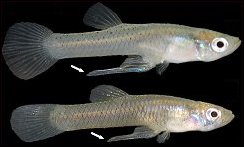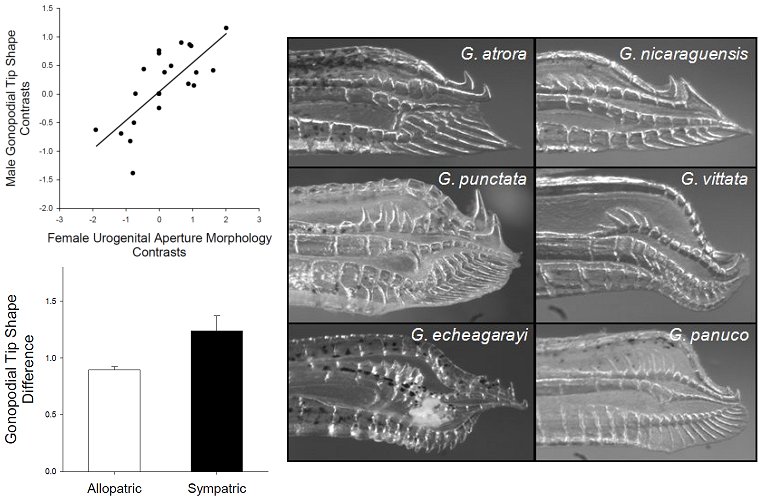Genitalia, particularly in males, is strikingly variable in animals with internal fertilization. Genital morphology may experience more rapid, divergent evolution than any other animal characteróbut why? Research in our lab investigates the orgins and consequences for the evolution of diversity in genital form in poeciliid fishes.
Livebearing fish in the family Poeciliidae display conspicuous variability in genital morphology, and represent a model system for understanding the evolution of genital form. Poeciliid males have evolved a modified anal fin, the gonopodium, that serves to transfer sperm to the female genitalia during copulation. Gonopodium size is highly variable in poeciliid fishes (see far-right figure, from Rosen and Gordon 1953), and research in our lab has revealed that a tradeoff between attracting mates and avoiding predators partly explains some of this variation, at least at the intraspecific scale (figures to the right, from Langerhans et al 2005 and Langerhans in press).

From Langerhans et al 2005.
There are nine hypotheses of genital diversification in poeciliid fishes (see Langerhans in press), and our lab investigates the relative importance of these nine mechanisms. Numerous lines of investigation are ongoing in our lab, such as understanding the functional morphology of gonopodium size and distal-tip elements, the function of female genital morphologies, comparative tests of genital divergence, and the role of genital divergence in speciation. Probably the most obvious form of genital diversity in poeciliid fishes lies in the distal-tip elements of the gonopodium (see far-right figure).
Recent work revealed that male and female genital morphologies coevolve in Gambusia fishes (see figure of independent contrasts to the right). Such coevolution is consistent with hypotheses of sexual conflict and lock-and-key. In support of the lock-and-key hypothesis, reproductive character displacement was additionally found in Gambusia fishes for both male and female genital morphologies, where genital differences among sympatric species are larger than differences between allopatric species, controlling for phylogenetic relatedness (see figure to the right, from Langerhans in press). This suggests that selection against hybridization has led to either evolutionary adjustments to minimize heterospecific insemination or community-level assortment of preexisting differences between species.
|




